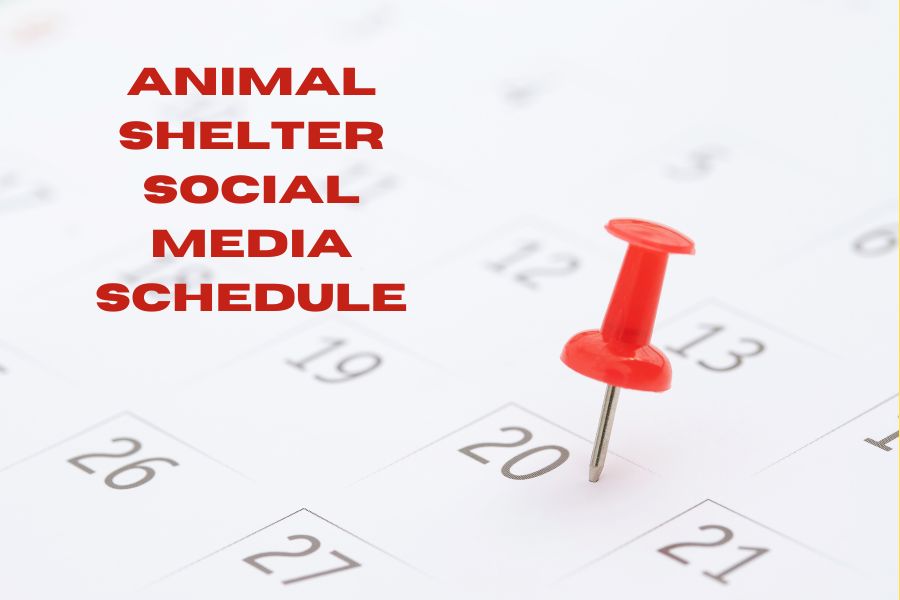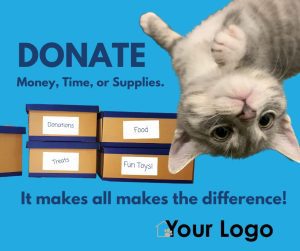To make a Social Media Posting Schedule, you need a content strategy. This involves connecting with your audience through consistent and interesting material. Here’s a sample schedule to incorporate into your marketing plan. We’ve included ideas for different types of posts to make each day.
Monday – “Meet the Team”
Showcasing your shelter’s staff and volunteers makes your organization seem more relatable. It also gives your followers an idea of what day-too-day life is like at the shelter. Highlighting the dedication and enthusiasm of the people who work with the animals might even inspire a few new volunteers!
- Highlight a staff member or volunteer with a short bio and their favorite animal.
- Share their role and provide quotes about why they are passionate about the shelter’s mission.
- Use behind-the-scenes photos or videos to make it personal. Try to make them interesting or funny.
Tuesday – “Adoption Spotlight”
It’s important to showcase the personalities and stories for each animal that’s up for adoption. These posts not only promote the shelter itself, but also bring attention to the dogs and cats that need homes.
- Feature a specific animal available for adoption.
- Share their story, personality traits, and any special needs.
- Include several high-quality photos and videos to showcase their cuteness.
Wednesday – “Wellness Wednesday”
Provide regular pet care tips and educational information. This shows that your shelter cares about the the animals’ well-being while promoting safe pet ownership.
- Share pet care tips, health advice, or educational content.
- Answer a common pet-related question or concern.
- Encourage audience participation with Q&A sessions.
Thursday – “Throwback Thursday”
Sharing the “before and after” stories of adopted animals always draws attention. They not only celebrate successful adoptions, but it also encourages people who might want to adopt by showing how the shelter improves the lives of animals.
- Share heartwarming “before and after” stories of adopted animals.
- Highlight their transformation from when they arrived at the shelter to the love they now receive.
- Invite adopters to share their own “throwback” stories.
Friday – “Furry Friends Friday”
Friday posts that are funny or make you feel good are a good way to end the work week. These types of posts give your cats and dogs personality, which makes them far more attractive to potential adopters.
- Show off adorable animals at the shelter.
- Share funny or heartwarming moments from the shelter.
- Use humor and captions to engage the audience.
Saturday – “Supporter Saturday”
Take this opportunity to recognize and give thanks to your supporters, volunteers, and sponsors. This helps build a feeling of community and gratitude. These posts help encourage other people to help out, volunteer, or give money.
- Recognize and thank a supporter, volunteer, or sponsor.
- Share their impact on the shelter’s mission.
- Encourage others to get involved or donate.
Sunday – “Success Story Sunday”
Sharing stories of animals who found loving homes are always a hit. They not only shows how the shelter assisted, but also motivates others to consider adopting.
- Feature stories of animals who found their forever homes.
- Include updates from adopters and heartwarming reunion photos.
- Inspire others to adopt by showcasing the happiness of adopted pets.
Monthly – “Events and Fundraisers”
Use Facebook and Instagram to promote your shelter events and fundraisers. Consider paid promotion for these types of posts to further spread the word.
- Promote upcoming shelter events, fundraisers, and adoption drives.
- Share event details, schedules, and how people can participate.
- Create eye-catching graphics and event-specific hashtags.
As Needed – Urgent Appeals and Updates
These posts help you address immediate needs. Common appeals include overcrowding, emergency adoption drives, or urgent requests for donations and volunteers. For better results, be sure to include specific reasons for the appeals, and follow up with status updates after.
- Share urgent adoption needs, such as overcrowding or special adoption events.
- Request donations or volunteer help when necessary.
- Keep the community informed about shelter news and important updates.
Engagement Posts – Randomly Throughout the Week
Engagement posts foster a sense of community and interaction with the audience. They encourage participation, feedback, and conversation, which not only boosts social media algorithms but also strengthens the shelter’s connection with its supporters.
- Pose questions to the audience, such as “What’s your favorite pet name?” or “Share your adoption story.”
- Conduct polls or surveys to involve followers in decision-making.
- Respond promptly to comments, messages, and user-generated content.
Visual Content – Regularly Throughout the Week
Visual information is easy to share and gets people’s attention more than just text updates. They also tend to be shared more often.
- Use eye-catching graphics and infographics to convey information.
- Share heartwarming and shareable images of animals in need.
- Experiment with short video clips, reels, and live streams for added engagement.
Consistency and Hashtags:
Consistency in posting helps ensure that your shelter stays top-of-mind with your followers. Adding relevant hashtags to your posts (Instagram) expands your reach and discoverability.
- Maintain a consistent posting schedule and time of day to maximize reach.
- Use relevant and trending hashtags to increase discoverability. #yoursheltername #animaladoptions #cutekittens #cutepuppies
- Monitor engagement and adjust posting times and content based on audience responses.
Take time to plan and diversify your social media strategy with a regular schedule. Plan ahead for special events and holidays. This helps create diversity in your content, improve outreach, and boost the chances of your dogs and cats finding loving forever homes!
Faqs
How can animal shelters measure the success of their social media strategy?
To effectively gauge the impact of their social media efforts, animal shelters should focus on a variety of key performance indicators (KPIs). Tracking post engagement rates is a basic step. This includes each post’s number of likes, shares, and comments. These numbers provide feedback on how much the content is liked. Additionally, monitoring the growth in followers over time offers insights into the broader appeal of the shelter’s social media presence.
What are some challenges animal shelters might face when implementing a social media schedule?
Animal shelters might face several challenges with their social media schedule. Limited resources can make it hard to post regularly. Shelters can use scheduling tools like Buffer or Hootsuite so posts can be planned in advance. Creating a content bank of evergreen posts can also help, so there’s always something ready to share. Engaging volunteers with skills in social media or photography can ease the content creation burden.
How can animal shelters effectively engage with followers who show interest in adopting or volunteering through social media?
Engaging with followers who show interest in adopting or volunteering requires a direct approach. Respond promptly to comments and any messages expressing interest. Provide clear next steps for them to take. This could be filling out an application form or visiting the shelter to meet the cat or dog. Above all, always thank people for their interest, and encourage them to share the shelter’s posts.









0 Comments